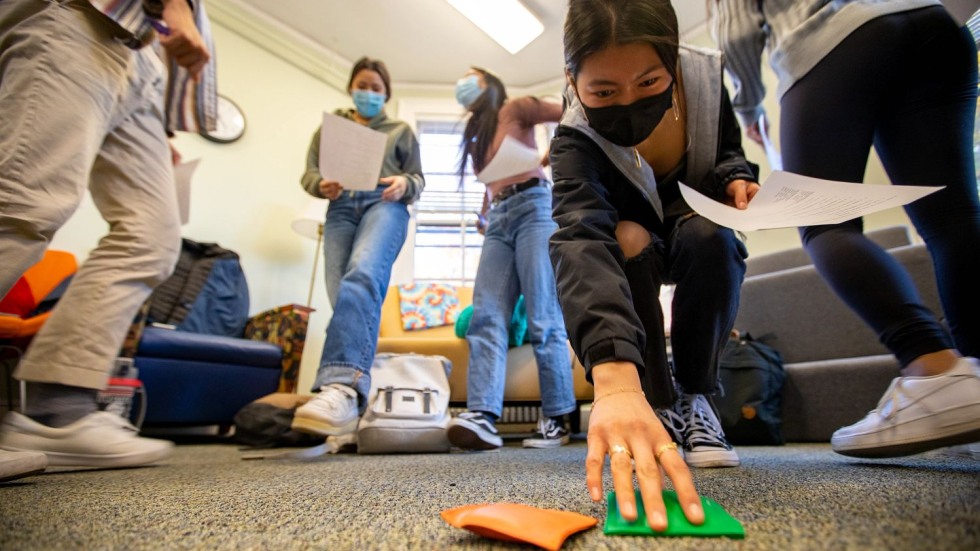From Narragansett to Yoruba, students strengthen their knowledge of international Indigenous languages.
Brown University
On a chilly November afternoon, a handful of undergraduate students at Brown University gathered in a cozy, casual lounge to dig into the particulars of the Hawaiian language.
Why,
one student asked, does the Hawaiian equivalent of “get in the car” sound more
like “get on the car”?
Because,
Makana Kushi explained, the phrase was developed to refer to a very different
kind of vehicle.
“In
Hawaiian, it’s more like ‘getting onto a car’ because it came from the way
Hawaiians would talk about launching a canoe on the water,” Kushi said.
Despite
a wide range of language courses offered at Brown, Hawaiian isn’t an official
class listed in the catalog. Neither is Navajo, Narragansett or Yoruba. Yet
during the Fall 2021 semester, 20 students at the University have met weekly to
learn one of 10 global Indigenous languages, including those four, for academic
credit.
That
experience has been made possible by Kushi, a Ph.D. student in American studies
and a program coordinator for Brown’s Native
American and Indigenous Studies Initiative. This semester, Kushi has
served as the advisor for a Departmental
Independent Study Project, a mechanism by which Brown undergraduates
can initiate, design and execute a course of their own with the help of a
faculty member or instructor.
The
project isn’t just allowing Brown’s Indigenous students to deepen connections
with their respective ancestral heritages and introducing those from other
backgrounds to these languages. It is also helping to keep Indigenous
languages, and thus Indigenous cultures, alive at a time when many are under
threat.
“Semester after semester, students would come up to me and ask if there was a way for them to study their native languages and get credit for it,” Kushi said. “It’s something a lot of students have tried to do in their spare time for years, only to have classes and social commitments undercut their efforts. They are all interested in preserving these languages for the sake of their communities, and they wanted a way to stay accountable.”

NAISI's expanded space has made it easy for Kushi to play interactive
games with her students — and for NAISI staff and students to
hold meetings, host events, relax and study.
On Wednesdays, Kushi herself teaches Hawaiian to six students taking the independent study for credit and a handful of auditors, leading grammar lessons, conversation practice and interactive games.
Throughout the rest of the week, other student-led groups gather to study languages such as Lakota, Yoruba, Maya and Diné Bizaad using textbooks, audio resources, dictionaries and other materials. With Kushi’s assistance, the students developed their own syllabi, created weekly assignments and established midterm and end-of-semester goals.
“They
created written goals that mirror many introductory and intermediate language
classes,” Kushi said. “They would say, ‘Okay, by the end of the first week, I
want to know how to introduce myself. By the middle of the semester, I want to
be able to write a paragraph. And by the end of the semester, I want to know
enough to have a conversation with my grandmother.’”
Kushi
said these goals reveal how, for Indigenous students at Brown, the intellectual
and the personal are inextricably intertwined. Many see their rigorous
coursework and extracurricular activities not just as stepping stones toward a
career but also as opportunities for self-discovery. One student taking the
independent study, for example, is writing a senior thesis on Indigenous
language loss in her community; learning the language not only helps her
transcribe interviews with elderly community members but also bolsters the
connection with her relatives.
That
interconnectedness is reflected in NAISI’s growth on campus, Kushi said.
“You
can’t really do Native American and Indigenous studies without cultural and
community elements,” Kushi said. “People are sometimes confused to find out
NAISI is an academic entity and not a student services organization, because we
do so much to support Indigenous students and are starting to engage with the
surrounding Indigenous communities. But I think that’s the ethos of Native
studies, right? Our educational mission is to serve Native communities in every
way — we serve them academically and personally, and we serve them whether
they’re at Brown or part of the local Native community whose land Brown occupies.”
